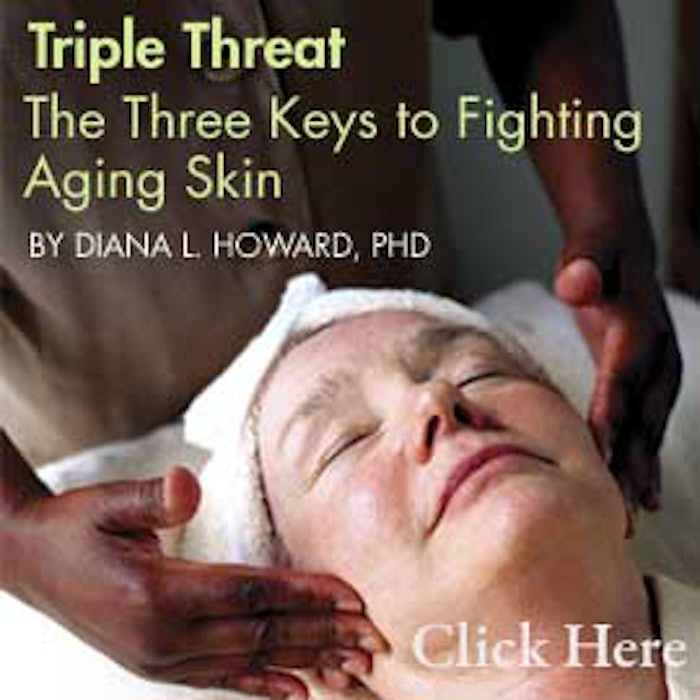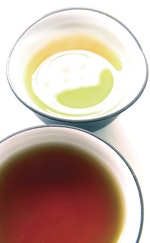
With 450 million baby boomers worldwide, it should come as no surprise that treating the signs of aging has blossomed. Latest estimates reveal that this market is now worth billions of dollars, and is anticipated to keep growing at a fast rate.
The causes of aging skin
The signs of aging—whether they appear on mature skin or prematurely aging skin—can be primarily attributed to ultraviolet (UV) radiation exposure. Although most are familiar with the symptoms of aging skin—wrinkles, rough texture, uneven pigmentation, dehydration and loss of elasticity—less attention is devoted to the processes that occur at a biochemical level to trigger these changes.
Most anti-aging products attempt to treat the manifestations of aging skin, such as wrinkles and sagging. In reality, there is only so much a person can do to address these issues through the use of topical products. The truth of the matter is that there is no cure for wrinkles. Yet, every time you log on to the Internet or open a magazine, you are bombarded with advertisements for products claiming to deliver the same results as injectable fillers without the use of a needle, or promising to deliver a face lift in a box. In order for clients to have realistic expectations, it is up to you to understand the science behind aging skin and teach them how to address these issues at their source.
Three primary biochemical reactions take place in the skin to contribute to the structural changes that are associated with aging. Initially, the skin’s antioxidant defense system loses its capacity to fight oxidative stress and the associated reactive oxygen species (ROS)—otherwise known as free radicals—that lead to aging. Combine this with an increase in the destructive matrix metalloproteinase (MMP) enzymes and an associated decrease in collagen synthesis, along with the formation of advanced glycation end products (AGEs), and the result is prematurely aged skin.
ROS
Free radicals, or ROS, occur naturally throughout a normal body metabolism. They also may be produced as a result of exposure to UV radiation, air pollution, smoking, alcohol and inflammation. ROS are formed when oxygen combines with other molecules resulting in oxygen molecules with an unpaired electron. These are unstable and travel throughout the body wreaking havoc, and causing the oxidation of DNA and structural components in the skin and body.

Fortunately, the body has natural defense mechanisms, such as antioxidants, to protect its tissues from ROS. However, its natural antioxidant supply often is not plentiful enough to provide adequate protection, especially in the skin. Studies have also demonstrated that exposure to UV radiation can inhibit antioxidant systems, so topical antioxidants are a good option for supplementing the body’s natural means of protection.
Combating ROS. How can you fight ROS in the skin? To scavenge these free radicals, look for antioxidants such as those found in white and green tea, grape seed extract, ascorbyl palmitate, ascorbic acid (vitamin C), glutathione, coenzyme Q10, tocopherol, tocopheryl derivatives (vitamin E), and genestein from soy and licorice. Glucosamine, lactic acid and magnesium ascorbyl phosphate should be sought out in order to fight hyperpigmentation. Many of these plant-derived ingredients are rich in polyphenols that include bioflavonoids, which are not only important antioxidants, but also are anti-inflammatory agents and cell protectants. Although the list of antioxidants in cosmeceuticals is indeed plentiful, these components are only beneficial when helping to prevent future signs of aging; they will not treat existing wrinkles or skin damage, but will reduce inflammation. It is important to note that ROS also lead to the formation of MMPs in the skin.
MMPs
MMPs are enzymes that, when activated, control matrix degradation in the dermis. Each MMP is a collagenase because it specifically decomposes particular collagens or other proteins in the extracellular matrix of the dermis. Collagenase is really a group of enzymes that are responsible for breaking down the different types of collagen and elastin. For example, collagenase-1, or MMP-1, acts on collagens I, II, III, VII and X. MMP-1 cleaves the triple helix strand of collagen into smaller fragments that spontaneously denature into gelatin peptides that are further degraded by other MMPs. This activity makes the MMPs critical for the remodeling of connective tissue, which is a critical part of aging and wound-healing.
MMP activity is highly controlled at different levels. Usually, cells do not maintain a pool of MMPs. They rely on their formation on an as-needed basis. The formation of MMPs may be stimulated by internal growth factors and inflammatory modulators, as well as exposure to UV radiation. Within hours of UV exposure, the MMP genes are activated, resulting in the biosynthesis of collagenase and other MMPs. Because collagenase degrades existing collagen and inhibits the formation of new collagen, long-term elevation results in disorganization and clumping—key characteristics of photoaged skin. Natural MMP inhibitors exist in the skin, but, as might be expected, they decline with age.
Combating MMPs. MMPs may be inhibited by topical agents, such as retinoids. Because of this, retinoids, including vitamin A, are recommended not only for reversing the signs of photoaging, but also for preventing the formation of MMPs, as well.
Bioflavonoids, including the proanthocyanidins from grape seed extract and the polyphenols from green and white teas, as well as French maritime pine, cranberry, rooibos tea, bilberry, black currant and soy phytoestrogens, are all excellent for controlling MMP activity.
For best results, obtain products that control MMPs while stimulating collagen, elastin and hyaluronic acid biosyntheses. These include peptides, retinol (vitamin A), magnesium ascorbyl phosphate (vitamin C), soy, phytoestrogens and yeast extract.
AGEs
Although most know that photoaging leads to the cross-linking of the collagen and elastin in the skin, it has only been in recent years that scientists have begun to understand more about this process. Collagen and elastin proteins are highly susceptible to an internal chemical reaction within the body called glycation. This is a nonenzyme-mediated reaction that takes place between free amino groups in proteins and a sugar, such as glucose. The same glucose that provides energy for the cells can react with proteins, such as collagen, resulting in the formation of AGEs and free radicals, which contribute to the cross-linking of protein fibers, the loss of elasticity and changes in the dermis associated with the aging process. When AGEs form in the skin, they activate a receptor site and form a complex known as RAGE (Receptor-AGE), which signals cellular processes that are related to inflammation and subsequent disease. Why is this so important? Because inflammation is detrimental to the aging process and occurs with many diseases.

Combating AGEs. Unfortunately, the list of ingredients that fight glycation is very limited due to the lack of research in this area. Look for products with specific Lys-Arg polypeptides, which have been shown to fight glycation, as well as soy isoflavonoids, which trap excess sugar molecules to prevent the formation of AGEs in the skin.
Educate your client
Although it may seem like these three biochemical reactions are isolated occurrences in the skin, it is important to note that they are very interconnected and influence each other. Collectively, they contribute to premature aging of skin. Understanding these biochemical phenomena enables you to educate your client about the types of products needed to address their skin conditions, and to encourage them to have reasonable expectations in regard to addressing aging skin.










